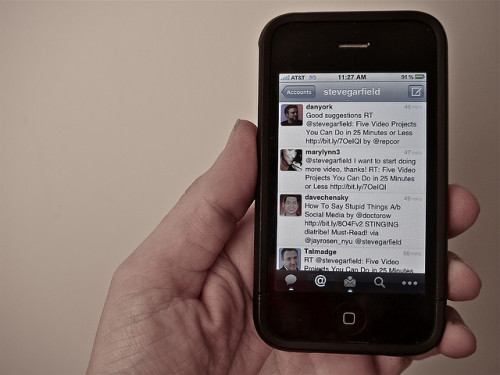Do a Google image search for terms like ‘tweeting’ or ‘people using Twitter’ and look through the results. Notice anything? Unless Google personalizes your search way differently from mine (and anyone I’ve asked), you’ll see a lot of images of the following type: a phone or tablet displaying some form of Twitter client, held by a hand or pair of hands. Very often, the perspective of the image asks us to imagine that hand as our own.

Now, those hands are almost without exception White (you have to scroll a while until you come across a darker skin tone). This is clearly out of touch with the reality of Twitter, which is in fact more popular among African American internet users than among White users.
But the point I want to argue is not so much about numerical representation as it is about what kind of place we imagine Twitter to be like.
When people first started noticing “blacktags” (hashtags that are more or less obviously connected to predominantly Black Twitter users or African American discursive practices), reactions were immediate and strong.
I don’t even want to go into the more openly racist comments—although Pete Kunze discussed these reactions in his post last week. Instead, I’ll look at responses from Black Twitter users themselves:
Such is the fascination w/ Black Twitter that there's a Wiki page? Like a whole, quoted & referenced Wiki page dawg? http://t.co/ryeNr12DM9
— nancioishiphop (@nancioishiphop) August 21, 2013
In her article “Language, Race, and White Public Space,” anthropologist Jane H. Hill argues that in much of American public life, White people are seen (or rather, not seen) as the invisible norm. Society imagines life itself to look White, sound White, and act White – and any deviation from that becomes a highly visible issue, something to be disciplined and regulated, or at least commented on.
“The fascination with Black Twitter is a troubling revelation because black Americans openly engaging in normal conversations within and not apart from a larger community should not be a groundbreaking reality.”
(Barrett Holmes Pitner @ The Daily Beast)
I think there is a danger that even while we find something “awesome” about “Black people being hilarious on social media,” such commentary constructs African American usage and experience as maximally different from “regular” (read: White) Twitter. (The Jane H. Hill article mentioned above goes into a lot more detail. Seriously, give it a read). The implication is that Twitter is by default an invisibly White public space and anything that’s not White warrants commentary.
@shebloggin its kind of weird, like Black Twitter is in a Petri dish. If it's fed after midnight, watch how it reacts and stuff.
— nancioishiphop (@nancioishiphop) August 21, 2013
This semester, our research group will be discussing the possibilities and writing practices Twitter offers activist users, and how these can be translated into pedagogical resources in the classroom. That these possibilities are real can be seen from plenty examples, ranging from #BlackLivesMatter to #NoDavisOnCampus or #IstandWithAhmed.
But before we start looking further into these hashtags and movements, it is worth recognizing that Twitter itself is not an idealized public sphere á la Habermas, where rational actors deliberate on an equal footing. Judging from the (White) media uptake of Black Twitter, Twitter begins to look a lot more like Hill’s White public space. We need to examine critically whose hands we imagine to be behind the iconic 140-or-less key strokes, and whose experiences and practices are being marginalized in the process.


